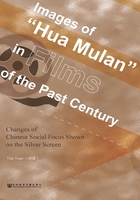
1.2 Five Filmic Adaptations
Mulan’s story has been adapted into numerous versions,such as Beijing Opera,stage drama,dance and so on. Compared with other art forms,movie is more popular and has stronger influence among the public. Generations of directors and screenwriters have produced their own filmic editions of the Mulan story,taking advantages of these characteristics of and vacancies in the original text,such as the multiple identities of the heroine and the lack of love stories. These five chosen movies,Mulan Joins the Army (1939),Hua Mulan (1956),Lady General Hua Mulan (1964),Mulan (1998) and Mulan:Rise of a Warrior (2009),are picked out as they have done well in fulfilling the cinematic potential of The Ballad of Mulan. Sue Parrill has pointed out that “like the best criticism,the best adaptation of books for film can throw new light on the original”.[28] Successful cinematic reproductions make an old story more attractive to audiences nowadays. Furthermore,all of them are commercial films aiming at the relevance to contemporary life,which earn great box-office and critical success and hold audience appeal over time. Finally,the time and place in which they are made are very representative.
Deborah Cartmell and Imelda Whelehan argue that “it is the additions not the deletions to the source that are largely responsible for an adaptation’s box office and critical success”.[29] This is especially true in the adaptation of classical works,as the audiences are so familiar with the original text that they do not expect the films to be exactly faithful. Instead,“it was the liberties taken rather than the faithfulness that is generally admired by reviewers”,[30] which means that it is the addition of the up-to-date elements that attract more attention. Referring to the adaptation of the legend of Mulan,the Chinese audience is so familiar with the original story that any cinematic version which is an exact repetition cannot stir any breathless buzz that directors really thirst for. Then changes are made according to certain contexts targeting on owning pedagogical effect on present-day audiences. In so doing,these picked movies vary from each other clearly in their combination of social backgrounds with the discussion of issues like war,family and love.
In detail,Mulan Joins the Army was produced in the semi-occupied Shanghai during the Sino-Japanese War (1937-1945) which was also part of the Second World War (1939-1945) and Hua Mulan (1956) was shot in Changchun,a Chinese city not far from the China-North Korea border,as a memoir of the “Resist America and Aid Korea”[31] campaign (1950-1953). Shot with genuine war background,patriotism became the core element,and both films spoke highly of the protection of motherland regardless of any possible personal sacrifice. In the meantime,as mobilizations of war,they worked as nationalistic rallying cries and showed vividly practices of wartime nationalism. By putting them back to the original social circumstances,people could get better understandings of the passion for war expressed totally in plots. However,there were still ideological differences behind their assertions of national identities. Mulan Joins the Army was mainly about protecting the motherland combining with certain amount of freedom of choice for females,while Hua Mulan added the idea of defending the socialism ideology together with the assertion of female independence and self-confidence. Each one echoed the popular voice of its own time.
Different from the above two versions,Lady General Hua Mulan was shot in Hong Kong,a British colony in the 1960s when the reconstruction after the Second World War was in the process. In this filmic version,war theme gave way to family ideas as the re-establishment of traditional virtues resonated with concurrent social needs. This could be clearly seen from the film narrative and form. For example,Mulan’s identity was more emphasized as a filial girl instead of a warrior. The excellent martial abilities she owned became a necessity for her to join the army in lieu of father. On finishing her work in the army,she refused the marriage offer from the general for his daughter,which was regarded by others as a kind of glory,and went back home to take care of parents as quickly as possible. To successfully protect the country was treated as an effective way of keeping family honour. With all this and many other details,the director successfully switched the focus from battlefield to household. Besides,the use of Huangmei Opera (an ancient folk opera in China) dubbing also worked as a reminder of the cultural heritage of the good old days,which could evoke resonance among the audience in the colony and reassured them about their traditional identities. Also it could let them forget about the traumas of war temporarily.
Mulan,the first Western approach of such a Chinese folk story made by Disney in 1998,was the biggest departure from the original works as it featured in the expression of feminism and individualism. It was actually an American film decorated with Chinese forms. The heroine was designed to be a rebellious girl who tried to prove personal ability. She stole father’s military memo and the family sword,left for the battlefield without let the elder know,and continued her struggle even after the unsuccessful disguise which got her a place in the army at the very beginning. War provided the stage for her to show herself while family became a source of her pressures from which she ran away. Plots like all this were highly unlikely to appear in Chinese films as they were against filial rules set by Confucianism. In contrast,Mulan:Rise of a Warrior,produced close to the 60th anniversary of the establishment of the People’s Republic of China,could be seen as a return to national culture together with the oriental giant’s latest views on personal development. Mulan was depicted as a successful general who was also a combination of traditional and present virtues,learning from the past faults and growing up with her indulgence. From theme to character setting to plot design,this filmic version showed a functional way to adopt the wisdom of the bygone eras to fulfil concurrent needs. One point worth thinking was that the gender boundary is blurred in this cinematic version.